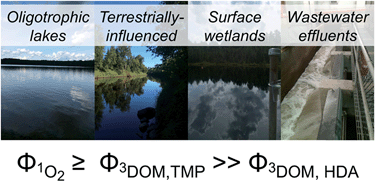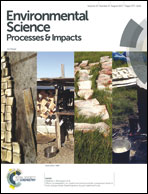The effect of probe choice and solution conditions on the apparent photoreactivity of dissolved organic matter†
Abstract
Excited triplet states of dissolved organic matter (3DOM) are quantified directly with the species-specific probes trans,trans-hexadienoic acid (HDA) and 2,4,6-trimethylphenol (TMP), and indirectly with the singlet oxygen (1O2) probe furfuryl alcohol (FFA). Although previous work suggests that these probe compounds may be sensitive to solution conditions, including dissolved organic carbon concentration ([DOC]) and pH, and may quantify different 3DOM subpopulations, the probes have not been systematically compared. Therefore, we quantify the apparent photoreactivity of diverse environmental waters using HDA, TMP, and FFA. By conducting experiments under ambient [DOC] and pH, with standardized [DOC] and pH, and with solid phase extraction isolates, we demonstrate that much of the apparent dissimilarity in photochemical measurements is attributable to solution conditions, rather than intrinsic differences in 3DOM production. In general, apparent quantum yields (Φ1O2 ≥ Φ3DOM,TMP ≫ Φ3DOM,HDA) and pseudo-steady state concentrations ([1O2]ss > [3DOM]ss,TMP > [3DOM]ss,HDA) show consistent relationships in all waters under standardized conditions. However, intrinsic differences in 3DOM photoreactivity are apparent between DOM from diverse sources, as seen in the higher Φ1O2 and lower Φ3DOM,TMP of wastewater effluents compared with oligotrophic lakes. Additionally, while conflicting trends in photoreactivity are observed under ambient conditions, all probes observe quantum yields increasing from surface wetlands to terrestrially influenced waters to oligotrophic lakes under standardized conditions. This work elucidates how probe selection and solution conditions influence the apparent photoreactivity of environmental waters and confirms that 3DOM or 1O2 probes cannot be used interchangeably in waters that vary in [DOC], pH, or DOM source.

- This article is part of the themed collections: Editor’s Choice: Aquatic Photochemistry and Natural Organic Matter


 Please wait while we load your content...
Please wait while we load your content...